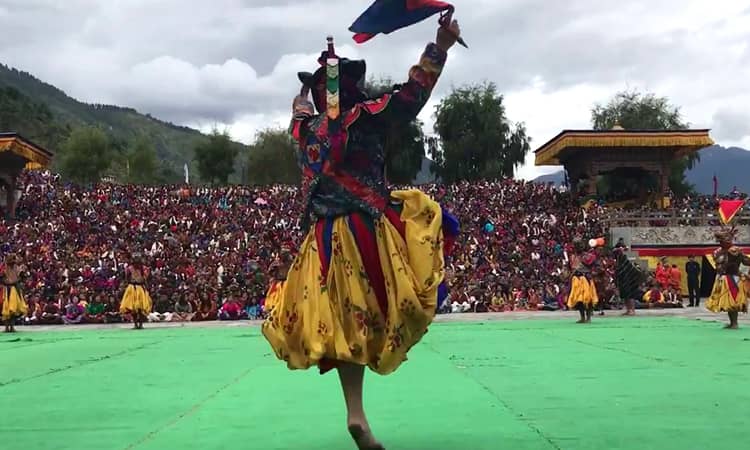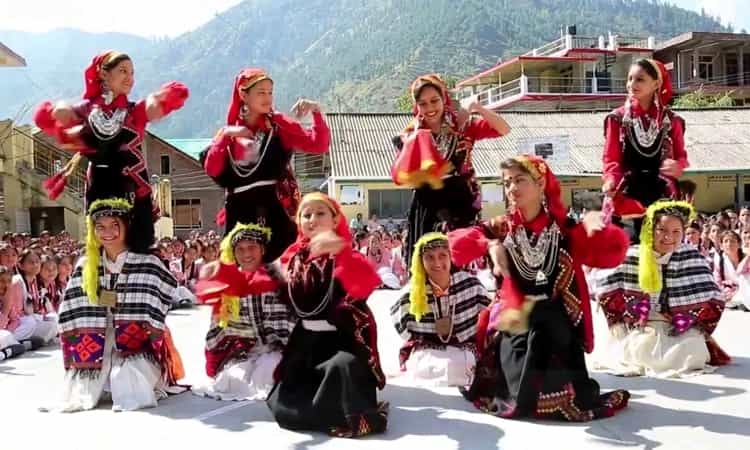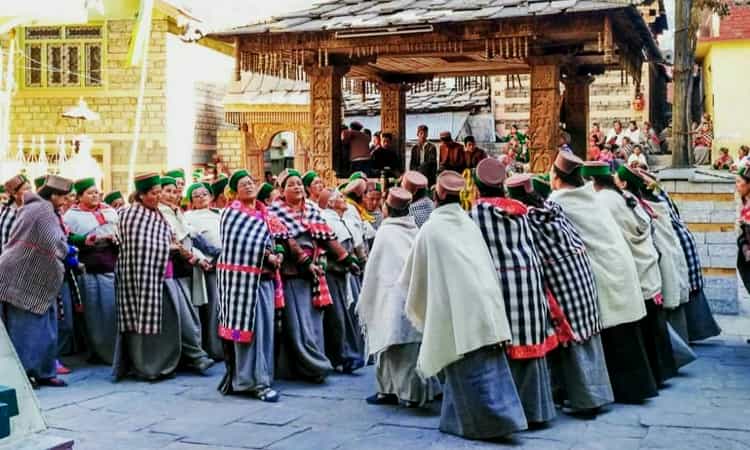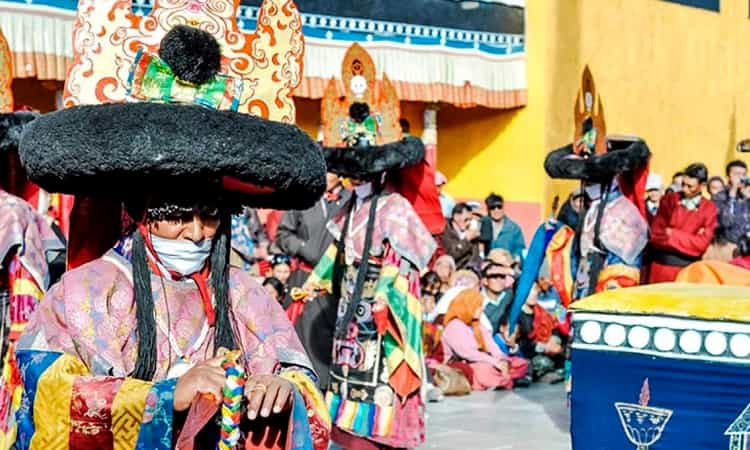Dev Bhumi Himachal Pradesh is all about snowcapped peaks, rich heritage and well-preserved culture. Dancing is one of the most calming and vibrant par
Dev Bhumi Himachal Pradesh is all about snowcapped peaks, rich heritage and well-preserved culture. Dancing is one of the most calming and vibrant parts of the culture of Himachal. The tribes and local communities love to express themselves through elaborate dances while being clad in traditional, colourful attire. People can learn a lot of things about them through their dances. Here is everything you need to know about the folk dances of Himachal Pradesh:
List of the 12 Traditional Folk Dances of Himachal Pradesh
1. Rakshasa Dance

Also referred to as the demon dance with a history deep rooted during the pre-history era of the Kinnaur region, this is one of the most well-preserved dances of Himachal Pradesh. The dance performance involves dancers wearing demon masks. The performance involves the depiction of a demon attack on the crops while the residents chase it away with the forces of the good. The dance is energetic and some people describe it as the Kinnaur folks acting like a playful deer. Men and women are placed in a circle holding each other’s hands while they follow the footsteps of the lead dancer called ghure.
2. Kayang Dance

Kayang or Kayang mala is a traditional folk dance of Himachal and is very eye-catching. The term is derived from the fact that the dancers hold each other’s hand crisscrossed from each other looking like they are tied together in the form of flowers in a garland. Every dancer is dressed up in vibrant clothing and beaded, traditional jewellery. Prior to the commencement of the dance, every dancer takes up a Gulp of Chhang, a locally prepared alcoholic beverage. The dance is associated with the districts of Una, Kinnaur, Chamba and Lahaul.
3. Bakayang Dance

Performed by the folks residing in the Kinnaur district of Himachal Pradesh, Bakayang Dance forms one of the most important dances in Himachal. The performers of this dance are mainly women who stand in rows of three or twos while facing each other. These women arranged in a specific order to move forward and backward to the traditional folk music playing in the background. It is a mesmerising dance to witness or even be a part of. The dance can be witnessed during special agriculture and harvest-related occasions and festivals.
4. Jataru Kayang Dance
The locals of Himachal sure know how to party and celebrate a festival. The locals can be seen primarily performing this dance during special occasions and festivals. It is also done while specific festival songs are being sung. As the music gains tempo, the dancers also start dancing joyfully following the steps of their leader with a chamar in their hands. The chamar becomes a great source of resentment and people begin to dance-fight with each other. The dancers even follow the steps of the lead dancers called ghure who also deposits a small fee to use the chamar as a prop.
5. Chohara Dance
Chohara dance is performed by both men as well as women during important and auspicious events. Himachali folks know how to celebrate their festivals and fairs with great love and enthusiasm. This folk dance is extremely famous among the people of Shimla district in Himachal and continues to be the headlining feature of every special occasion. One can witness the great wonders of Himachal through this dance.
6. Shand Shabu Dance
When it comes to folk dances the locals of Lahaul are very rich in culture. The Shand Shabu Dance is prominent in the Lahaul and Spiti districts of Himachal. Lahaul is home to numerous Buddhist Gompas all over the state and this dance is performed by the monks of these gompas. The term Shan means a song of prayer for Buddha and the dancers who know how to dance to this traditional shand music are known as Shan dancers. The dance is also performed by the people of the tribal community during the completion of their crop harvest season. Shehnai and stringed instruments are used as music sources in the performance. The dance can be dubbed to be similar to the Shabbo dance which is commonly performed during festive occasions.
7. Lang-Dar-Ma Dance

Also referred to as the evil king dance, this masked dance is unlike any other traditional Himachali dance in the state. It goes on for hours at a stretch and tells the story of the murder of the evil king called Lang Dar-Ma. The dance is one of the most famous masked dances that is mainly done in Lahaul Spiti district. The king was a Tibetan emperor that reigned from 838 to 841 CE. His evil nature was well known since he was rigidly Anti-Buddhists. The dance is extremely captivating where the dancers twirl and whirl around wearing traditional clothing. If you watch closely you will be able to unlock the meaning behind the dance and get more interested in the story the dance attempts at conveying.
8. Nati Dance
Nati is a traditional folk dance of Himachal Pradesh that is also famous and recognised across the globe. Nati is a local term used to describe the traditional folk songs sung in the western and central regions of India. It has gained popularity in districts of Shimla, Kinnaur, Kullu, Mandi, Chamba, Sirmaur etc. along with some districts in the hill state of Uttarakhand. Men and women participating in the dance hold each other’s hand across the waist and move to the music and beats of percussion instruments. Did you know that Nati dance is also listed as the largest folk dance in the world in the Guinness book of world records.
9. Jhanjhar Dance
This famous dance originates from the Chamba district of Himachal, every festive occasion witnesses this grand dance celebration. The dance is performed by both men as well as women wearing traditional and elaborately coloured clothing. This is a song which is absolutely captivating in every sense. The dance starts off in a slow pace and rhythm which gradually ascents its speed and beats after which it finally ends. The dance is so electrifying and infectious that it gets the audience going as well. Any festive occasion, fair and festival witnesses this dance being performed in large groups.
10. Jhora Dance
Jhoor is one of the main dance forms of Sirmour district in Himachal Pradesh. It is an important dance since it is done as an opening act for any dance or festival performance. It is a fun dance to witness as it is extremely interactive in nature. The dance involves dancers interacting with each other through questions and answers that are both delivered in a musical tone. The main feature of this dance is that each line ends with a ‘Hoo Hoo’ sound that the dancers scream out in joy. The dance is a delightful experience for both dancers as well as the viewers.
11. Gi Dance
Adding on to the list of interesting, fun and unique folk dances of Himachal Gi is another one. The gi dance is performed to the intricate and detailed beats of 3 divisions. As a part of the dance performance, the Gi Dancers stand in the form of a circle while the mian or the lead dancer stands in the centre with arms stretched out and dancing along with the others. The person in the centre of dance can also be seen rotating in a mesmerising fashion that will encapsulate the sense of the audience. There are different forms of Gi dances that have evolved with time and changes from region to region, depending on the community.
12. Rasa Dance
The traditional Rasa dance of Himachal is one of the most beautiful forms of Himachali folk dance that captures the true spirit of the state. It combines the most interesting facets of the culture and lifestyle of the people like Gids, goddesses, traditional musical instruments, crops harvesting and tools. Both men and women dancers participate in the rasa performance while wearing their traditional colourful clothes. The footwork and hand movements are simple and follow the beats and sounds of the music being played in the background. The dancers slowly mingle together to create a circle and hold hands across each other’s waists and dance with great happiness and enthusiasm.
Frequently Asked Questions (FAQs)
Q. When Is The Best Time To Visit Himachal Pradesh?
Ans. The best time to visit Himachal is from March to June.
Q. Can I See Snow In Himachal?
Ans. Yes. Many places in Himachal get covered in snow during the peak winter months from December to February.
Q. What Are The Must Visit Places In Himachal?
Ans. The must visit places in Himachal are: Manali, Shimla, Kufri, Dharamshala, Khajjiar etc.
Q. What Are The Famous Foods Of Himachal?
Ans. Famous Himachali dishes include Rajma, Maash Daal, Chhole, Siddu, Dham, Thenthuk, Thukpa etc.
Q. What Is The Official Language Of Himachal?
Ans. The official language of Himachali is Hindi.


COMMENTS